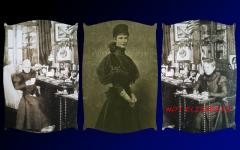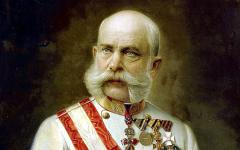Queen Elisabeth's Bathroom and Bedroom in the Royal Palace of Gödöllő
In this paper, I will reveal where Queen Elisabeth's bathroom was furnished in the Royal Palace of Gödöllő, and where exactly the simple iron bed she slept on was set up in her bedroom. Furthermore, I will confirm the fact that Sisi's upstairs suite was connected with a private spiral staircase to the ground floor not only in Schönbrunn Palace but also in the Royal Palace of Gödöllő. The next time you visit the palace, you can also try to find out based on the description below, where Elisabeth's former bathroom could be furnished, and where her iron bed could stand.
Elisabeth is famous for her cult of beauty, which included regular baths and hair washing. Initially, Sisi did not have her bathroom in the Hofburg, instead she, like other members of the imperial family, was given a washbasin that was placed in her bedroom. Of course, this was not enough for her so after her wedding, her suite must have been provided with a wooden tube (which was taken in daily). The Viennese court welcomed with a shock that the young Empress took a bath every day, taking off all her clothes. The court of Archduchess Sophia - because it never really became Sisi's one - was ruled by the strict Spanish etiquette, which was considered a bit obsolete already at that time. Elisabeth’s steps to preserve her beauty and youth caused some indignation at the court. However, they were not unique in Europe. Several high-ranking guests staying in the Viennese court of the Emperor of Austria were surprised to find a lack of bathrooms. In Vienna, Archduchess Sophia ruled the court, perhaps that was why the most modern bathroom of the time was built for Elisabeth in Hofburg relatively late, in 1876. (Archduchess Sophia died in 1872.)
Elisabeth around 1862. Coloured photograph by Joseph Albert. Hungarian National Museum Hungarian Historical Gallery.
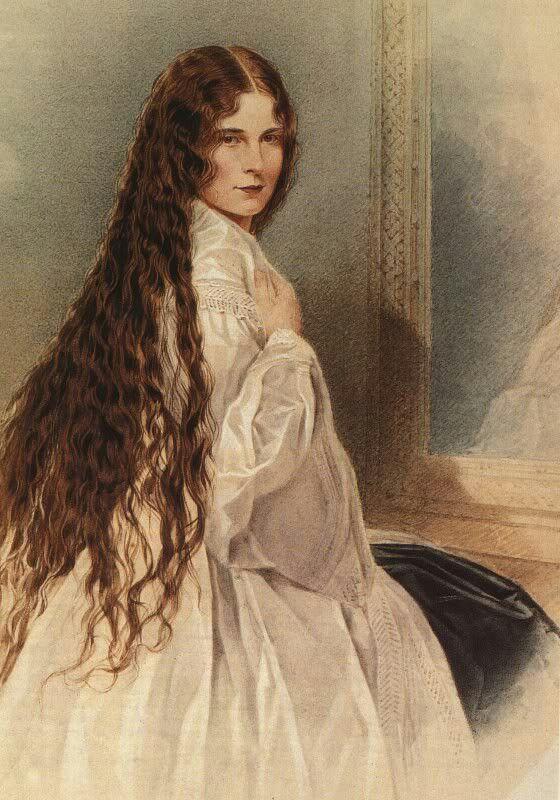
Elisabeth could have a permanent bathroom in the Hofburg only after her mother-in-law's death. However, in the Royal Palace of Gödöllő, where she slept more than two thousand nights, was reconstructed and furnished as she wanted, after the Austro-Hungarian Compromise of 1867.
Walking through the palace, many may ask the question: If Elisabeth considered her daily cleansing ritual so important why cannot we see her bathroom? I have been preoccupied with this issue since I was a child and visited the palace museum the very first time. I was sure the Queen had a permanent bathroom in her suite, and not just a tub-appropriate facility was taken to her daily bath, as in the Hofburg, which she disliked. The palace was reconstructed and furnished to meet Elisabeth's wishes needs. So why would the bathroom have been left out? Knowing Elisabeth’s character and needs, I would consider the non-existence of a tub to be out of the question. But where could Sisi's bathroom be?
VIENNA - HOFBURG: 1. Sisi's bathroom at the Hofburg in Vienna © Schloß Schönbrunn Kultur- und Betriebsges.m.b.H. / Alexander Eugen Koller. 2. Elisabeth's living room and bedroom at the Hofburg in Vienna. Elisabeth's living room at Hofburg also functioned as a bedroom at night. The servants brought in the Empress' simple iron bed and set it in the center of the room, separated by a Spanish wall from the living area. © Schloß Schönbrunn Kultur- und Betriebsges.m.b.H./ photo by Knaack. Visit the attractions relating to Elisabeth and Franz Joseph in Vienna: Hofburg (Sisi Museum, Imperial Apartments, Imperial Silver Collection), Schönbrunn Palace and Imperial Furniture Museum. Sisi Tickets to all the attractions: here.
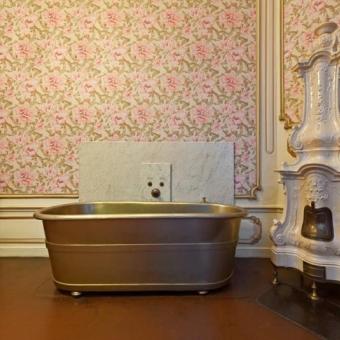
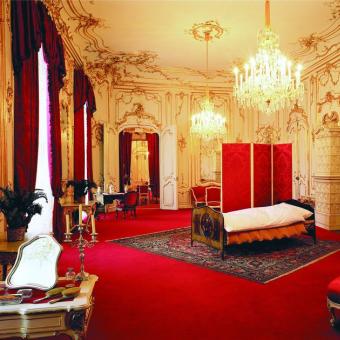
Sisi's bathroom in the Royal Palace of Gödöllő
(The picture above shows Elisabeth's bathroom in Hofburg, there is no picture of a bathroom in Gödöllő.)
"…The curtained part is furnished as a bathroom."
I had been searching for the answer to this question for a long time until one day I came across the book "Gödöllő, The Home of the Royal Family (1896)" by Ferencz Ripka. A reprint of this old edition was published by the Gödöllő Town Museum in 2000, which I bought in the shop of the Royal Palace. This work presents detailed descriptions about the furnishings of each room of the Royal Palace in 1896, including the paintings on the walls, and several small details. The Queen’s upstairs suite is also discussed on more than two pages by the author, Ferencz Ripka (1896): “The right side of the front of the palace is inhabited by the Queen. These harmoniously decorated magnificent rooms used to be dominated by the colour of the majesty's favorite flower, violet, but now, as in the king's suite, the red is predominant. From the large hall, opens the small salon, which is one of the most beautiful rooms in the palace. The walls are covered with tapestries, and there is silk-covered, red, richly gilded furniture in Rococo style. Its two windows open onto the ‘Queen’s Garden’. (…) Next to the small salon is our Queen's writing room, which is furnished with only a small wallnut desk, a set between the two windows and a bookcase. Behind the set, a mirror covers the wall. There is a bronze statuette on the top of the bookcase (..). The electric-lit room is divided into two parts by an upholstery. The curtained part is furnished as a bathroom.” (Ripka, page 38-41)
Queen Elisabeth's suite in the Royal Palace of Gödöllő. The photo is from Ferencz Ripka's book of 1896 (photographer - Erdélyi)
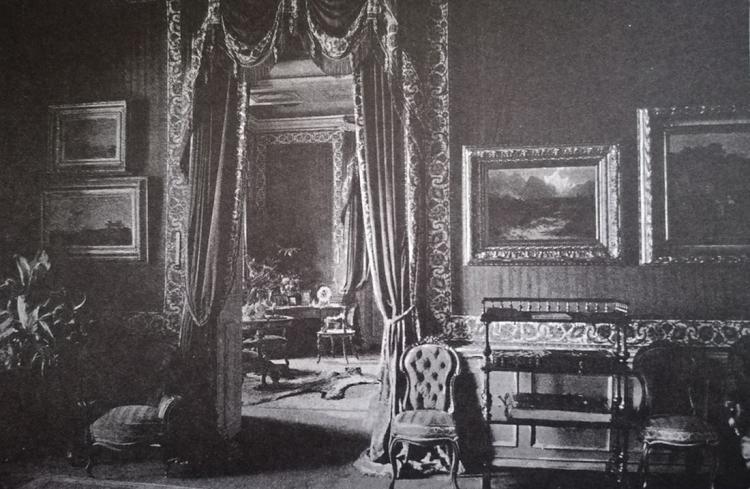
In Ripka's last two sentences, we find a clear hint that Elisabeth had a bathroom on a permanent basis in Gödöllő. Ripka certainly walked through the halls of the palace and made a detailed description - with the permission of Franz Joseph, of course - when the royal family was not staying on the estate. It was not difficult to find this time in 1896, as in the 1890s, the royal family rarely stayed in Gödöllő. At that time, the restless Elisabeth was mostly on a journey. In his book, Ferencz Ripka (his name is spelt like that in Hungarian: Ripka Ferencz) recalls the times when the Queen spent her time so joyfully on her beloved estate. We can be sure that if a part of her writing room had been converted into a bathroom only when she had her daily bath and only separated by a Spanish wall for bathing, Ripka would not have been able to see it either. We might never know exactly what this room might have looked like. The Royal Palace experienced difficult times after the death of Franz Joseph. Almost everything from furniture to window handles were stolen or destroyed. The former Maria Theresa's bedroom, which Elisabeth used as a bedroom (Maria Theresa had slept there only for a few days when visiting Count Grassalkovich, the builder of the palace) covered in red marble and a marble fireplace might have been left only because they could not be removed (they are so well-constructed). The same goes for the horse drinkers in the marble stable, which survived but were painted gray. The castle was almost on the brink of destruction by the time help arrived. In 1985, conservation works could begin slowly.
The marble stable on the estate of the Royal Palace of Gödöllő. The photo is from Ferencz Ripka's book of 1896 (photographer - Erdélyi)
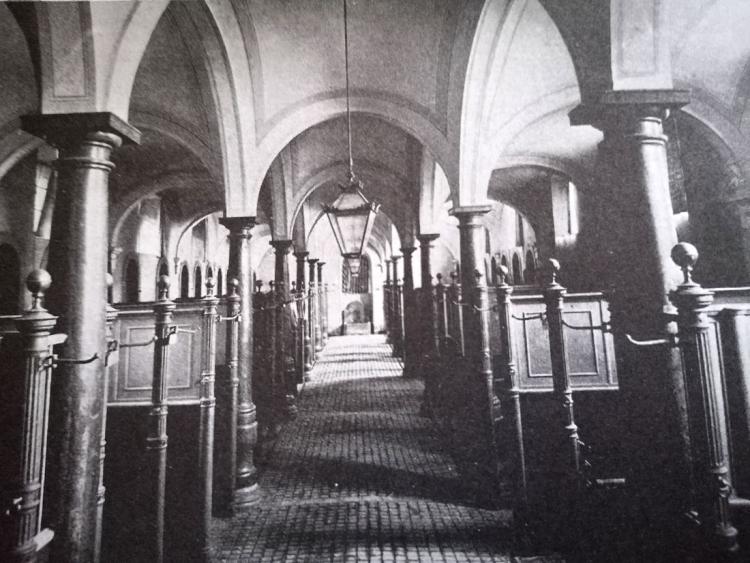
It took a tremendous amount of work for the curators, restorers and interior designers to restore the former conditions as authentically as possible. The first permanent exhibition of the Palace Museum opened in 1996. (And since then, more and more rooms are reconstructed.) Of course, the question has always arisen: Which condition should be restored? The royal period? The Grassalkovichs one (they were the builders and the first owners of the estate)? Or a later one?
Elisabeth's writing and dressing room in the Royal Palace of Gödöllő - now © Royal Palace of Gödöllő
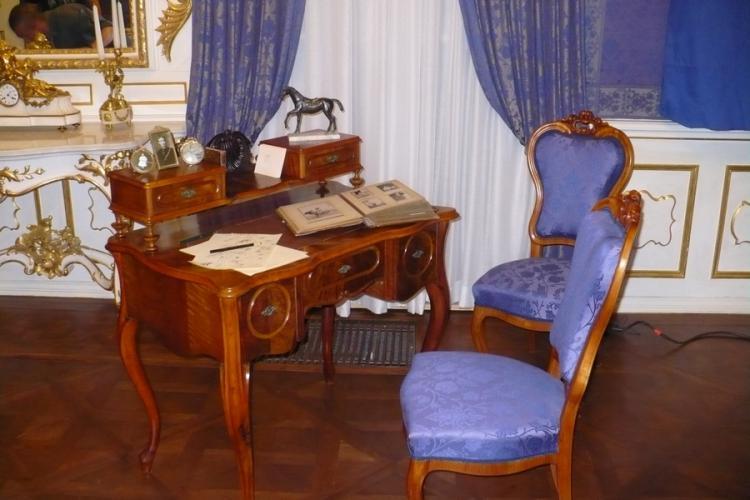
Now let us be back to issue of Sisi's former bathroom. “The curtained part is furnished as a bathroom,” wrote Ferencz Ripka in his description. Comparing the above-mentioned facts, it is clear from this single sentence that a part of the room functioned permanently as the Queen's bathroom. Of course, it was probably not equipped with the most modern facilities of its time. (Elisabeth's most modern bathroom was in Hermes Villa, which was built between 1881 and 1884 in the Lainz Game Park in Vienna.) The Royal Palace of Gödöllő was modernized several times during the royal period, for instance, they provided the royal suites with air heating and electricity. However, permanent bathrooms were not built because if yes, traces of it would have been found during the restoration work of the building (when the palace was turned into a museum in the 1990s). Elisabeth's bathroom could not have running water either, the servants had to take the water into the tub. The Queen probably did not mind it because when Franz Joseph built the Hermes Villa for her, she allegedly was sorry that more maids could lose their jobs by building plumbing bathrooms.
The Queen's writing and dressing room in the Royal Palace of Gödöllő. The assumed location of the bathroom is in the writing and dressing room above. This dressing room opens from the room below (writing room) and the Queen's marble bedroom. (The writing room below opens from the Queen's Salon, which leads to the Ballroom. On the other side of the Ballroom is the King's Suite. More about the Royal Suites: HERE) © Royal Palace of Gödöllő
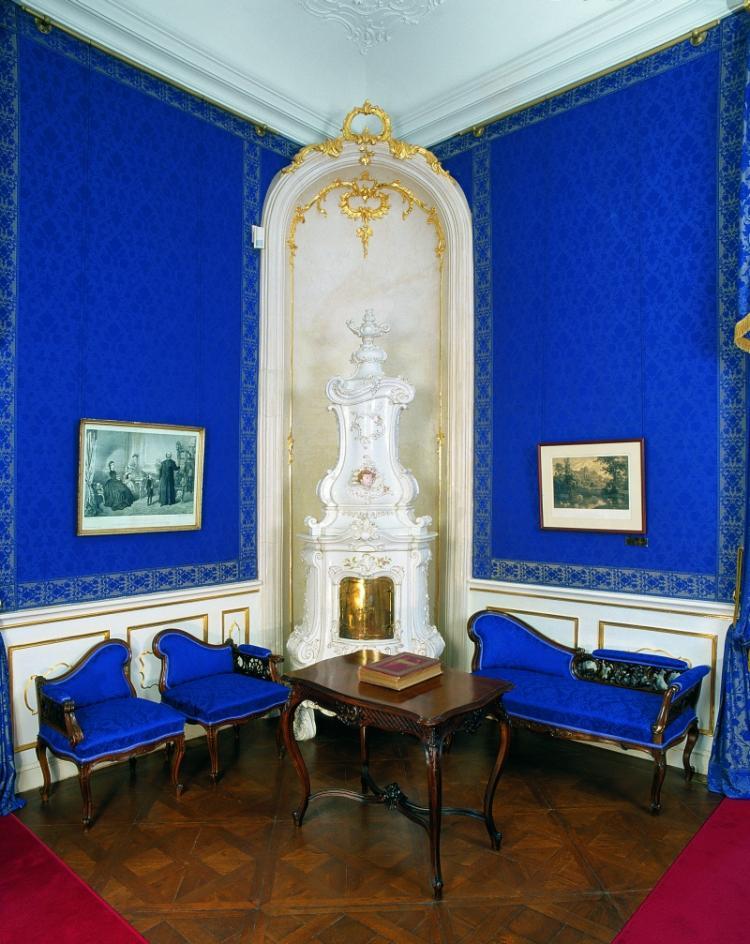
"Our Queen's simple wide iron bed"
Ferencz Ripka continues his description (in his book, 1896): "Its side walls are made of red marble, with very rich gilding; the ceiling is a real masterpiece. A bedroom window opens onto the ‘Schimmelhof’ and has a chaise-longue ['chaise-longue' - it is how Ripka called it] on each side. Along the wall facing the window, in the middle, is our Queen's simple wide iron bed, the length of which is set towards the inside of the room, and above it, a gilded Hungarian crown decorates the shiny marble wall. Two protruding walls separate one part of the room, in which on the wall facing the door is the notable memorial large oil painting depicting the dignified figure of Maria Theresa touching three crowns at once with her right hand. This great painting is lit by light coming through a small glass door. This door connects the bedroom to a foyer, from where a spiral staircase leads to the two lounges on the ground floor, which comfortable, round-shaped violet sofas decorated with live flowers provide the most attractive homeliness.” (Ripka, page 41)
Elisabeth's bedroom in the Royal Palace of Gödöllő © Royal Palace of Gödöllő
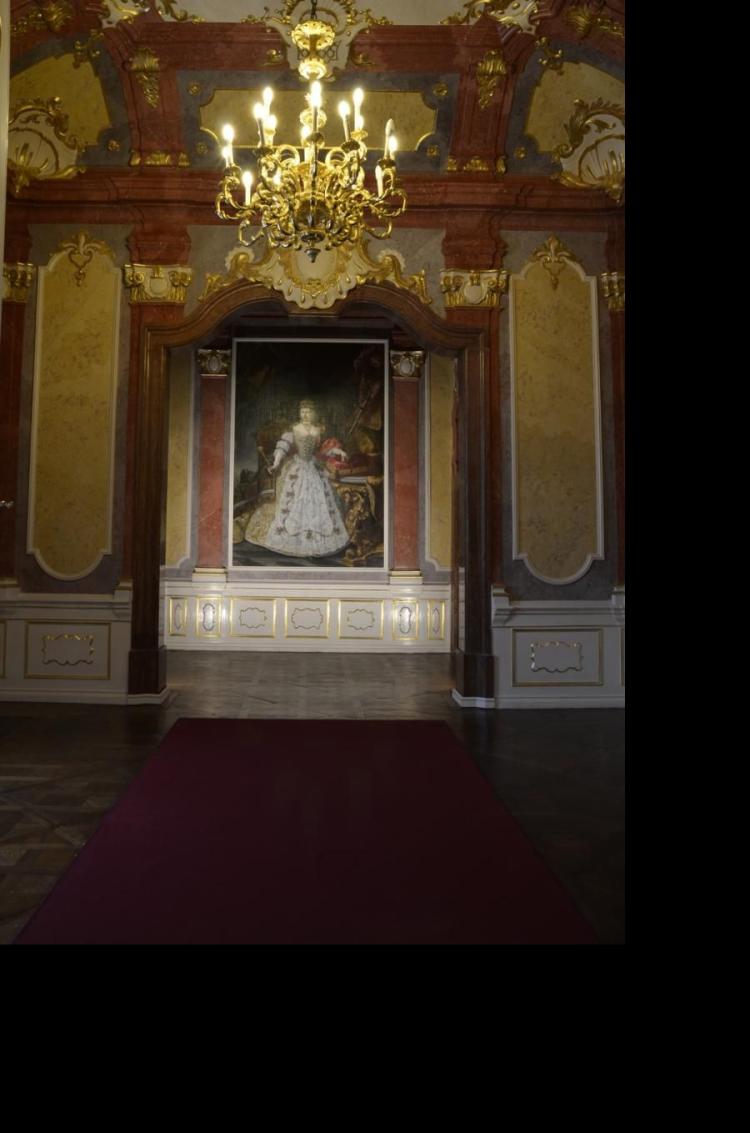
Let us have some more words about Elisabeth's iron bed in Gödöllő: Ripka's book contains a contemporary photograph of the marbled bedroom, which, unfortunately, does not show this iron bed, only the sofa in front of the window. Is it possible that, as in the case of the iron bed at Hofburg, her bed was only brought into the bedroom by the servants in the evening? At the Hofburg, Elisabeth's huge living room also functioned as a bedroom - Sisi's bed was placed in front of the fireplaces at night and separated from the sofa and armchairs by a small Spanish wall. This can be seen in a similar state to the original in Vienna today (only with the difference that the Spanish wall is taller and shorter than the one which stood there in Elisabeth's time). No matter how luxuriously furnished the Hofburg was (the official winter residence of the Habsburgs), Sisi complained a lot that she was cold. Archduchess Sophia considered any modernization in Burg to be completely unnecessary. In her beloved Gödöllő, Elisabeth probably never was cold. During the renovations and modernizations of the Royal Palace in the late 1860s, the royal suites were equipped with an air-heated system, which was operated from a ground-floor heating room. Franz Joseph liked to economize whenever it was possible. However, for his wife, he was almost always willing to pay whatever she wanted (of course, most of the renovation and reconstruction was certainly financed by the Hungarian Treasury - the palace was still owned by the Hungarian State, the royal family only used that - it was the royal couple's wish).
The fact that the Queen's bed was not in place at the time of the photograph for Ripka's book (shortly before or in 1896) also confirms that Elisabeth's bathroom in Gödöllő can be called "permanent". If the tub had been brought to her for each bathing time, Ripka certainly would not have been able to observe and record it in his book. It is probable that it was not appropriate to make a description about (or perhaps a photograph of) the bathroom for a publication commemorating the royal family's stay in Gödöllő. I do not know about the existence of any other documents about Sisi's bathroom in Gödöllő. During the Millennium Celebrations of 1896, Queen Elisabeth honored the Hungarians with her last official representation - she refused to appear in public at that time. Her last visit to Hungary was in October 1897. At that time she stayed in her suite in the Palace of Buda, so, probably after the publication of Ripka's book, Gödöllő could no longer host the Queen. After Elisabeth died in 1898, Franz Joseph left her suites both at Schönbrunn Palace and Hofburg unchanged — everything was left there as if her beloved Sisi could return at any time. He probably ordered the same in the Royal Palace of Gödöllő.
Barbara Káli-Rozmis, researcher of Empress Elisabeth of Austria and Queen of Hungary
All of my articles on this website are protected by copyrights. I kindly ask you not to use them without my permission. My official: website
The official website of the Royal Palace of Gödöllő: click here.
Elisabeth's first visit to Hungary
The Love of a Mother: Empress Elisabeth’s first child, Archduchess Sophie. Subtitled video.

